Banyan,
Strangler, and Epiphytic Figs
By Jerry Meislik
Aerial
Roots and Banyan Trees
In the tropics
there are trees that appear to be a grove or small forest of
trees and may cover a few acres. On close inspection they are
actually a single tree with secondary trunks arising from its
branches. This style of tree is called a banyan, and is named
after the Asian Indian traders who gathered around and under
the trees to conduct their daily business and keep out of the
intense sun.
The banyan
style is not specific to Ficus but occurs in numerous different
types of trees including Ficus, Schefflera, Pandanus, mangrove
and other plant families.
Ficus microcarpa
with many aerial roots near the main trunk.
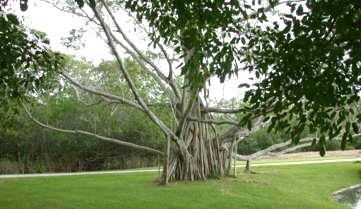 |
Magrove with a curtain
of fine aerial roots.
 |
Pandanus with many
prop roots.
 |
Even within
the Ficus or fig family there are species that form aerial roots
and others that never form aerial roots and banyan formations.
Aerial roots allow the tree a way to survive on inhospitable
terrain such as rocks, and even other trees . Many figs start
life on other trees. These are called strangler or epiphytic
figs.
A young eppiphytic
fig growing on the left side of the palm tree trunk.
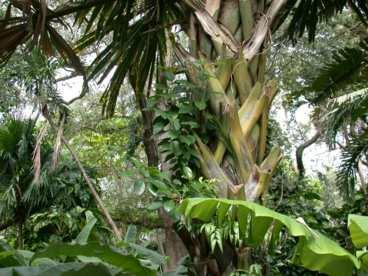 |
The banyan
style can be accomplished in bonsai with the appropriate tree
materials. Ficus, Schefflera and Brassaia will spontaneously
form a banyan type grove. With the figs aerial roots form on
mature wood but not on green twigs. Humid conditions and shade
promote moisture accumulation on the tree, and this stimulates
small whitish-brown bumps and small roots to form on branches
and trunk.
Small "bumps"
begin to form aerial roots on this fig's trunk.
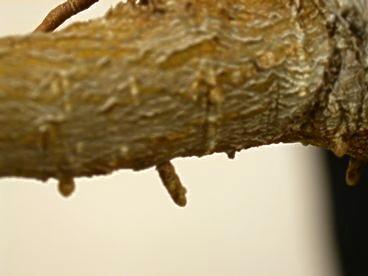 |
These tiny
roots elongate, grow downwards, and are shaped by wind and other
disturbances into pillars, spirals, or many other possible configurations
Aerial root is elongating.
 |
Once the root
succeeds in growing into the ground it becomes thicker, stiffer
and also shortens a bit.
Aerial root has elongated
and rooted into the ground.
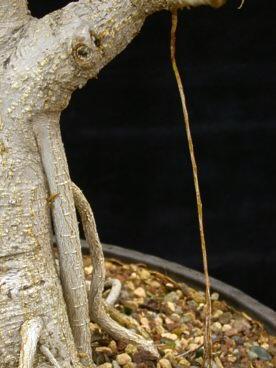 |
Aerial roots,
which are not anchored in the ground and fortified with mature
bark are susceptible to drying and death. Immature aerial roots
are brittle and can break off with careless handling.
Encouraging
Aerial Roots
In bonsai
culture encouraging aerial roots involves techniques to keep
the bark moist, and to maintain high humidity. Lucky growers
in the tropics with high humidity and constant warmth have no
problems in developing aerial roots. Under northern and indoor
growing conditions aerial roots are much more difficult to establish
due to the lower humidity levels, and the lack of overhead watering.
Once aerial
roots begin to elongate they can be helped by anything that keeps
the roots from drying out. Moss carefully draped around the new
roots; drinking straws in which the roots have been inserted;
bottles of water into which the roots have been directed; plastic
baggies around the roots all allow the roots to remain moist
and to grow into the ground. Once secured in the ground the roots
toughen and then require no special maintenance.
The red lines indicate
two drinking straws which enclose aerial roots guiding them to
the soil or into a dish of water.
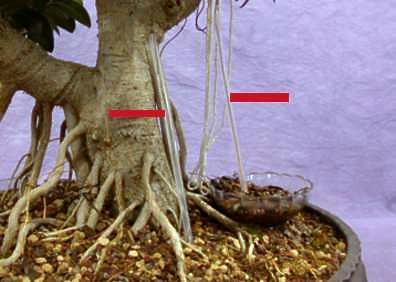 |
Other
Techniques for Developing Aerial Roots
There are a few techniques to successfully
place a root exactly where you want it. This involves grafting
either a root or seedling tree to the host plant. First, remove
some fresh long roots from the fig that you wish to graft. In
my case I was repotting a Ficus salicifolia. I removed four long
unnecessary roots, and these were used immediately and were not
allowed to dry out. The roots were from the same tree but probably
roots of the same species would be fine as well. If using roots
from another species the bark character may not be similar and
therefore the roots will look out of place.
I simply planted several inches of
the root end into the pot in the exact spot were it was wanted.
The length of the root that was exposed to air should be wrapped
in moist sphagnum moss and then covered with plastic to keep
the root moist until it successfully roots. Notch the branch
on the mother tree and inserted the cut end of the root. Make
the notch or hole in the branch slightly smaller than the root's
diameter. Then use cut paste around the joint graft, but be careful
not to wiggle it apart. For stability, wire the new aerial root
joint to the host branch. This protects the joined areas from
moving in the wind or from being bumped when watering.
In sixty to 120 days you will find
the root has taken as signified by its increasing girth. If the
graft fails the root will shrivel up. Once the root has taken
the protection wire may be removed and the wrapping moss and
plastic can be removed. The successful root will be in the right
spot and at the right angle. If the graft does not succeed then
get another root and try it again; you have not lost anything
but a worthless extra root.
A second but similar grafting technique
is to use a small fig tree to graft into the host tree exactly
where a new aerial root is required. Notch the host area wide
enough to receive the small trunk and allow the grafted tree
to grow wildly for 3 - 4 months. After that time the seeding
should be fused into the host tree; then the top of the seedling
may be cut off allowing the trunk of the seedling and its roots
to remain. Again an aerial root was developed exactly where needed.
Styling
a Banyan Tree
Styling a banyan is as individual
as styling any bonsai, but it is very trying since multiple "trunks"
and complex surface root systems are involved. Roots and trunks
should be consistent in character and preferably not at random
angles. Trunks should be similar in configuration, that is, all
upright or all twisted. The branch structure can be anything
from formal upright, informal upright or anything else, but the
aerial roots must complement the overall pattern.
As with any art piece, if
there is "too much" going on there will be confusion
and the design may not work. Aerial roots/trunks should be selected
for their size position, and shape. The aerials may be wired,
replanted at better angles, or removed if not needed. Manipulation
of aerial roots should only be done after they become woody and
less fragile.
 
|

